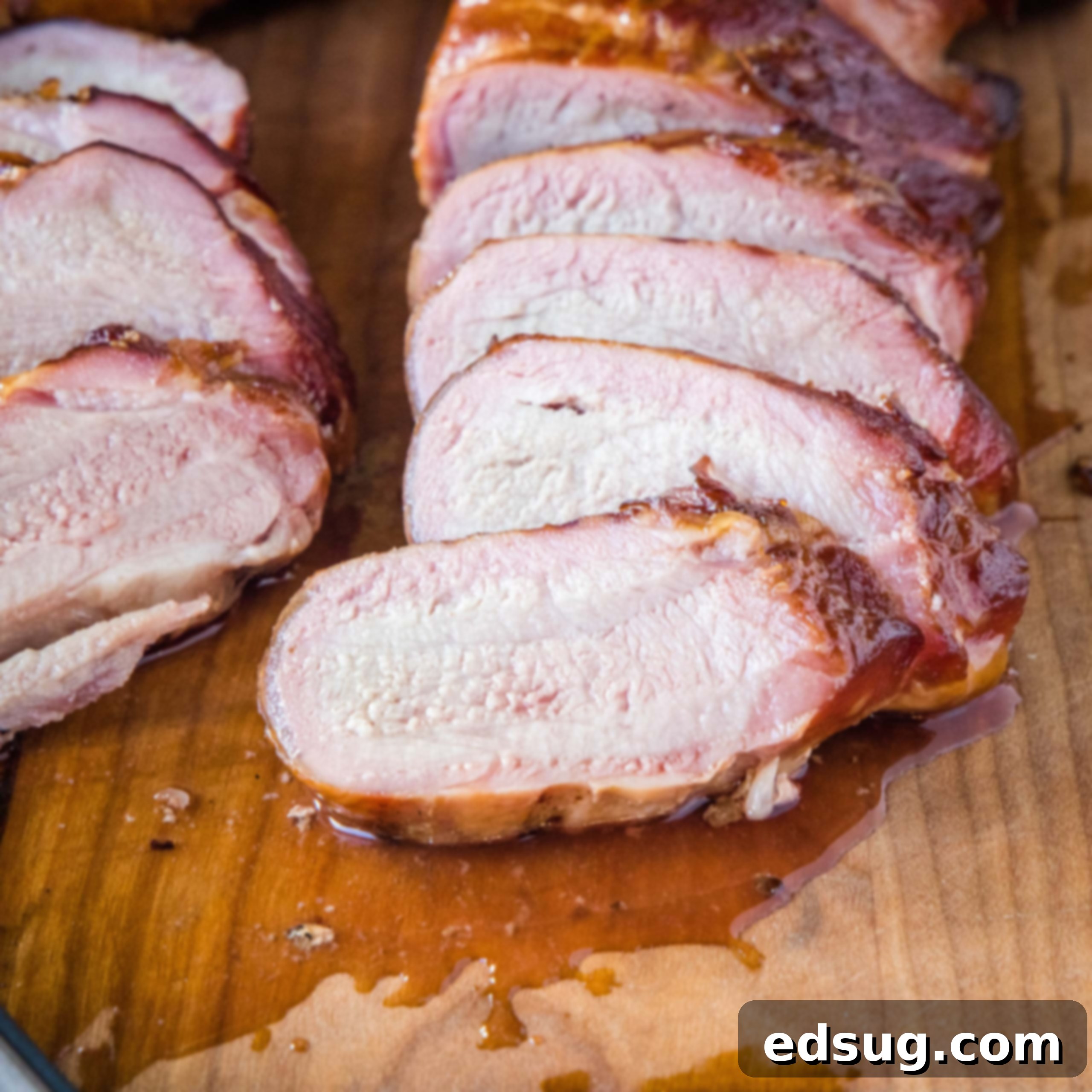Juicy Smoked Pork Tenderloin: Your Ultimate Guide to Flavorful Smoking Perfection
Tender, juicy, and packed with incredible flavor – smoked pork tenderloin is a surprisingly easy protein that’s perfect for any night of the week, whether it’s a quick family dinner or a relaxed weekend cookout.
This post is sponsored by Best Food Facts and United Soybean Board. All thoughts and opinions are 100% my own.
Last week, following my trip to Des Moines with Best Food Facts, I was excited to share insights into soybean farming, its sustainability practices, and the nutritional benefits of soy, as detailed in my Chocolate Tofu Pudding post. Today, I’m thrilled to bring you a fantastic summer dinner recipe that highlights one of my absolute favorite soy products: soy sauce!
Seriously, who doesn’t love the rich, umami depth that soy sauce adds to a dish? It’s a game-changer in this marinade, infusing the pork with an irresistible savory sweetness before it hits the smoker. This recipe comes together with minimal effort, requiring just a little over an hour of smoking time for an easy and unforgettable meal.
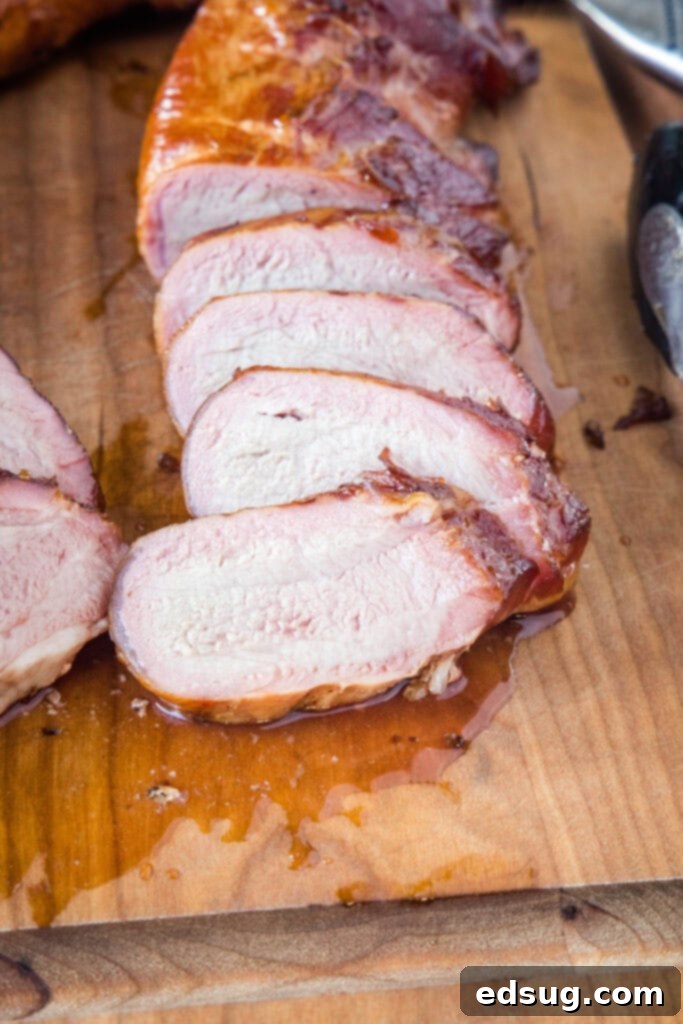
Beyond its incredible flavor contribution, soy sauce brings some notable nutritional benefits to the table. Soybeans, the foundation of soy sauce, are naturally cholesterol-free and rich in essential nutrients. They are an excellent source of protein and fiber, and also provide valuable amounts of vitamin B6, phosphorus, and iron. Furthermore, soy sauce is known for its antioxidants and isoflavones, which are beneficial plant compounds. While traditional soy sauce can be high in sodium, I always opt for the reduced-sodium variety to keep things healthier without compromising on flavor.
Crafting the Perfect Smoked Pork Tenderloin Marinade
When it comes to smoking meat, many of us reach for a dry rub to achieve that classic smoky bark. However, for pork tenderloin, I’ve found that a well-crafted marinade truly elevates the flavor profile, adding a different dimension that a rub alone can’t quite achieve. A marinade penetrates deeper into the meat, tenderizing it and infusing it with moisture and complex flavors that complement the smoky notes from your cooker.
The beauty of this marinade is its flexibility: you can let the pork soak for as little as one hour if you’re short on time, or up to 24 hours for maximum flavor absorption. This makes it incredibly convenient for meal prep – whip it up the night before or first thing in the morning, and you’ll have a ready-to-smoke tenderloin by dinner time.
Key Marinade Ingredients and Their Role:
- Soy Sauce: The star ingredient, delivering a powerful punch of umami, saltiness, and savory depth. Using a low-sodium version helps control the overall salt content while still providing that essential flavor base.
- Honey: Adds a touch of natural sweetness that balances the savory soy sauce and caramelizes beautifully during smoking, creating a gorgeous exterior.
- Olive Oil: Helps distribute the fat-soluble flavors throughout the meat and keeps the tenderloin moist during cooking.
- Brown Sugar: Further enhances the sweetness and aids in caramelization, contributing to that desirable “bark” on the surface.
- Garlic: A foundational aromatic that provides pungent, savory notes crucial to the marinade’s overall taste.
- Onion Powder: Offers a milder, more pervasive onion flavor that complements the garlic without overpowering it.
This harmonious blend of sweet, savory, and aromatic ingredients creates a marinade that not only tenderizes but also builds layers of flavor, ensuring every bite of your smoked pork tenderloin is incredibly delicious and juicy.
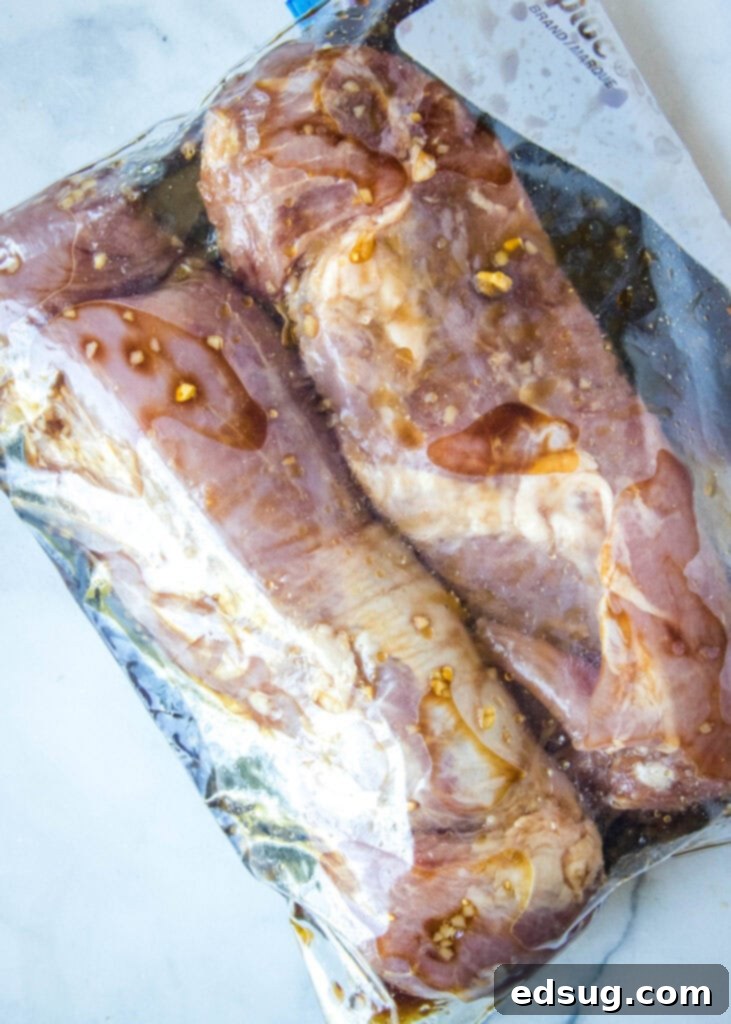
How To Smoke Pork Tenderloin: A Step-by-Step Guide
Smoking pork tenderloin is a straightforward process that yields incredibly tender and flavorful results. Here’s how to master it:
- Prepare the Marinade: In a bowl, thoroughly mix together the honey, olive oil, brown sugar, low-sodium soy sauce, minced garlic, and onion powder until well combined.
- Marinate the Pork: Place your pork tenderloins in a large, food-grade storage bag (a resealable plastic bag works great). Pour the prepared marinade over the pork. Seal the bag, pressing out as much air as possible, and gently “squish” it around to ensure the pork is fully coated.
- Refrigerate: Store the marinating pork in the refrigerator for a minimum of 1 hour, and up to 24 hours. The longer it marinates, the more flavor it will absorb.
- Preheat Your Smoker: About 15-20 minutes before you’re ready to cook, preheat your smoker to a steady 225ºF (107ºC). Ensure your wood chips or pellets (apple, cherry, or pecan work wonderfully with pork) are ready and producing a clean, thin blue smoke.
- Smoke the Pork: Once your smoker is up to temperature, remove the pork tenderloins from the marinade (discarding any excess marinade). Place the tenderloins directly on the smoker grate, ensuring there’s space for smoke to circulate. Cook for approximately 60-90 minutes.
- Check for Doneness: The most crucial step is to cook until the internal temperature reaches 145ºF (63ºC) in the thickest part of the tenderloin. We’ll delve deeper into this below.
- Rest and Serve: Once the target temperature is reached, remove the pork from the smoker and let it rest on a cutting board, loosely tented with foil, for at least 3 minutes. This allows the juices to redistribute, ensuring maximum tenderness and juiciness. After resting, slice the tenderloin into medallions and serve. It’s fantastic on its own or topped with your favorite barbecue sauce for an extra layer of flavor.
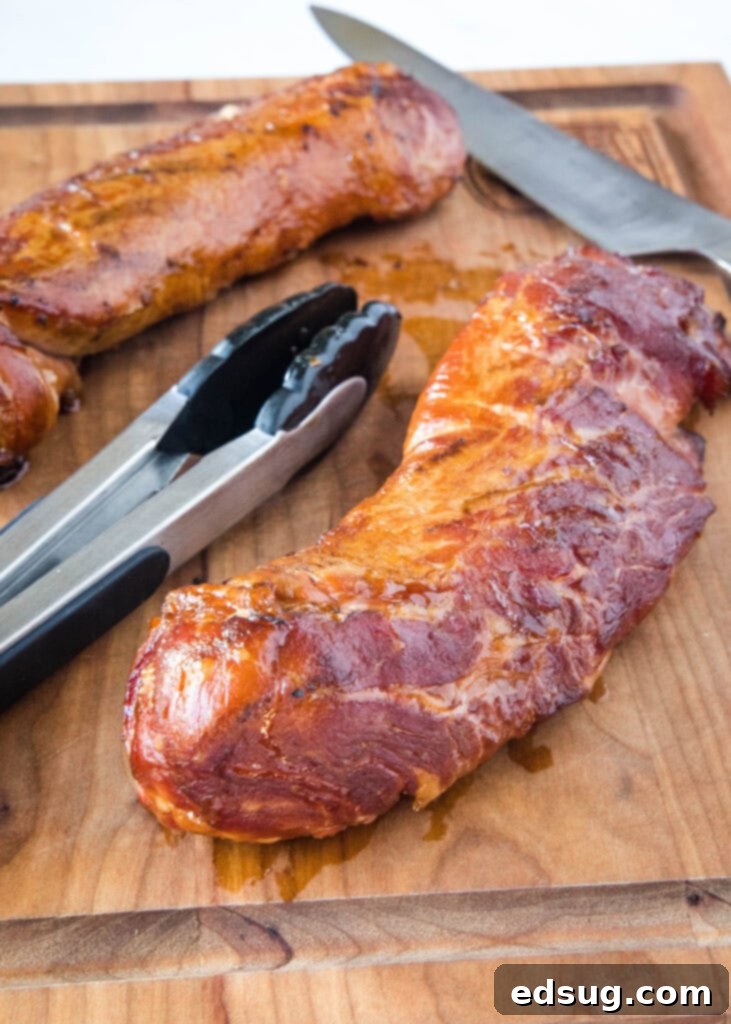
How Long To Smoke Pork Tenderloin for Perfect Results
The smoking time for pork tenderloin typically ranges from 60 to 90 minutes. However, this is merely an estimate. Several factors can influence the actual cooking duration, making a meat thermometer your most reliable tool for achieving perfect doneness:
- Size and Thickness: Pork tenderloins vary in size. Those purchased from a standard grocery store might be smaller and thinner than those found at a wholesale club, leading to shorter cooking times. Thicker tenderloins will naturally take longer.
- Smoker Consistency: The ability of your smoker to maintain a steady temperature significantly impacts cooking time. Fluctuations in temperature can extend or shorten the process.
- Ambient Temperature: On colder days, your smoker might work harder to maintain temperature, potentially increasing cooking time.
As with smoking any cut of meat, relying solely on time can lead to inconsistent results. Always cook to the desired internal temperature, using a reliable meat thermometer to guide you. This ensures your pork tenderloin is never undercooked or, more commonly, overcooked and dry.
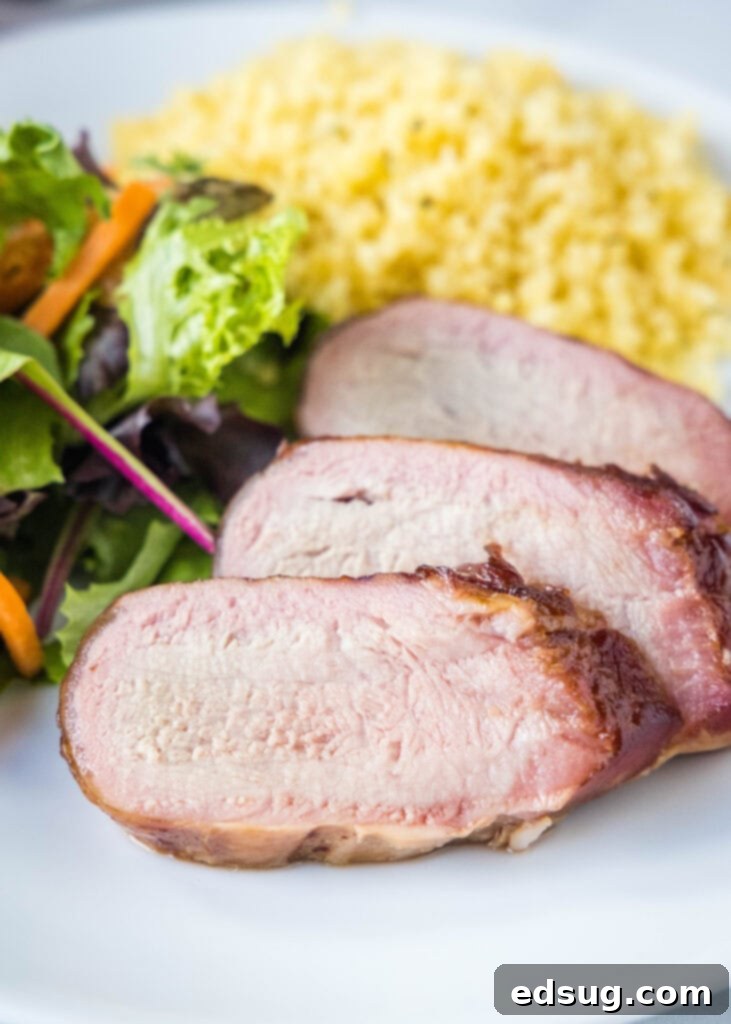
The Gold Standard: Perfect Smoked Pork Tenderloin Temperature
The key to achieving incredibly tender and juicy pork tenderloin lies in cooking it to the correct internal temperature. The USDA recommends cooking pork to an internal temperature of 145ºF (63ºC), followed by a 3-minute rest. Many people avoid pork, fearing it will be dry, but this is almost always a result of overcooking. When cooked to the precise temperature, pork tenderloin is wonderfully moist and tender, often with a slight pink hue in the center, which is perfectly safe and desirable.
Why a Thermometer is Essential:
- Accuracy: Every cut of meat is unique, and smoking conditions can vary. A good quality meat thermometer eliminates guesswork.
- Prevents Overcooking: Overcooking is the number one enemy of tender pork. Hitting 145ºF and then resting ensures maximum juiciness.
- Food Safety: While visual cues can be misleading (especially with pork tenderloin, which can remain slightly pink even when fully cooked), a thermometer provides a definitive answer for food safety.
I personally rely on the Thermapen Mk4 for checking meat temperatures throughout the cooking process. It’s incredibly accurate and provides instant readings, which is invaluable when you’re aiming for precision. Insert the thermometer into the thickest part of the tenderloin, avoiding any bone or gristle, for the most accurate reading.
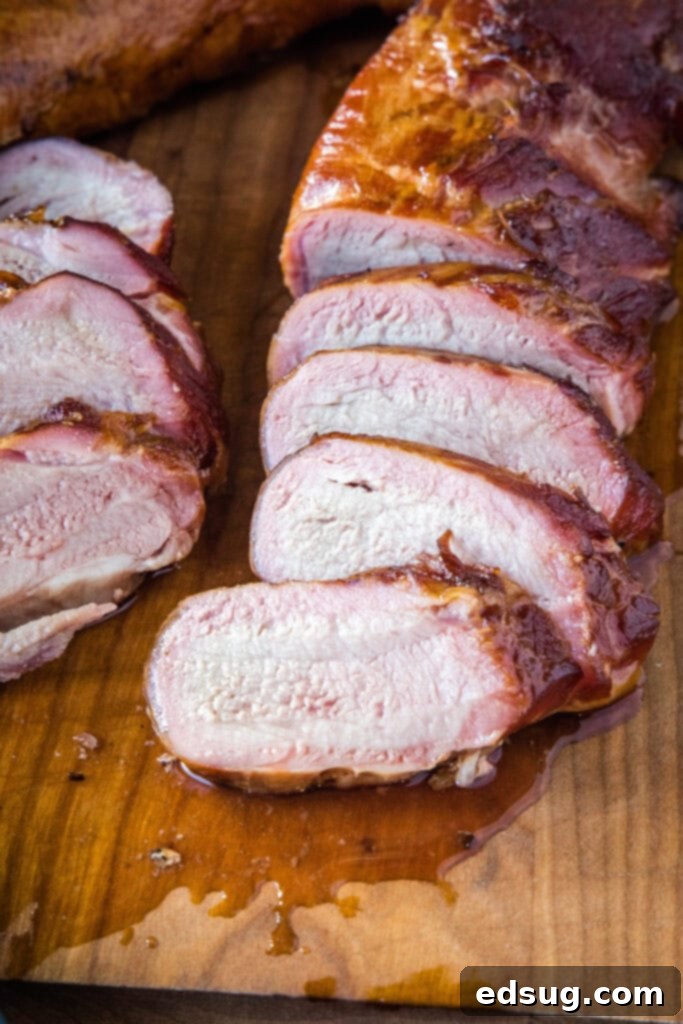
Delicious Sides to Serve with Smoked Pork Tenderloin
Smoked pork tenderloin is a versatile main course that pairs beautifully with a variety of side dishes. Here are some of my favorite recommendations that complement its rich, smoky flavor:
- Cheddar Broccoli Rice: A creamy, comforting side that offers a nice contrast to the lean pork.
- Smoked Potatoes: Doubling down on the smoky goodness, these potatoes absorb flavor from the smoker and are incredibly satisfying.
- Caprese Pasta Salad: A fresh, vibrant, and light option, perfect for cutting through the richness of the meat, especially in warmer months.
- Baked Beans: A classic barbecue companion, offering sweet and savory notes that always hit the spot.
- Roasted Asparagus or Green Beans: Simple, elegant, and healthy vegetable options that can be quickly roasted while the pork rests.
- Creamy Mashed Potatoes: A timeless classic that provides a smooth, rich base for the tender pork.
Pork Tenderloin vs. Pork Loin: Understanding the Cuts
It’s common for people to confuse pork tenderloin and pork loin, but they are distinctly different cuts with varying characteristics and best cooking methods:
- Pork Tenderloin: This is a long, narrow, and lean cut of pork that comes from along the backbone. It’s renowned for its incredible tenderness and fine texture. Tenderloins are quick-cooking and best suited for high-heat methods or smoking at lower temperatures, as in this recipe, to preserve their moisture. They tend to have a slightly darker color, and even when fully cooked to 145ºF, they may retain a desirable pinkish hue, unlike pork loin which typically cooks to a paler white.
- Pork Loin: In contrast, pork loin is a much wider, flatter, and larger cut of meat, often sold as a roast. It can sometimes be found bone-in. Pork loin is also tender but has a milder flavor compared to tenderloin. Because of its larger size and sometimes varying fat content, it’s excellent for roasting, grilling, or slow smoking. While it’s a great cut for smoking, it will take significantly longer to cook than a tenderloin. For more information and a delicious recipe, check out this Smoked Pork Loin.
On a related note, the connection between pig farming and soybeans is fascinating and something I learned more about during my farm visit. It turns out that a significant number of pig farmers (around 64%) also grow soybeans on their farms. These soybeans are then used as a nutritious feed for the animals. In turn, the manure from the pigs is utilized to fertilize the soybean crops, creating a closed-loop system that exemplifies sustainable farming practices. It’s a wonderful example of how different aspects of agriculture can work in harmony.
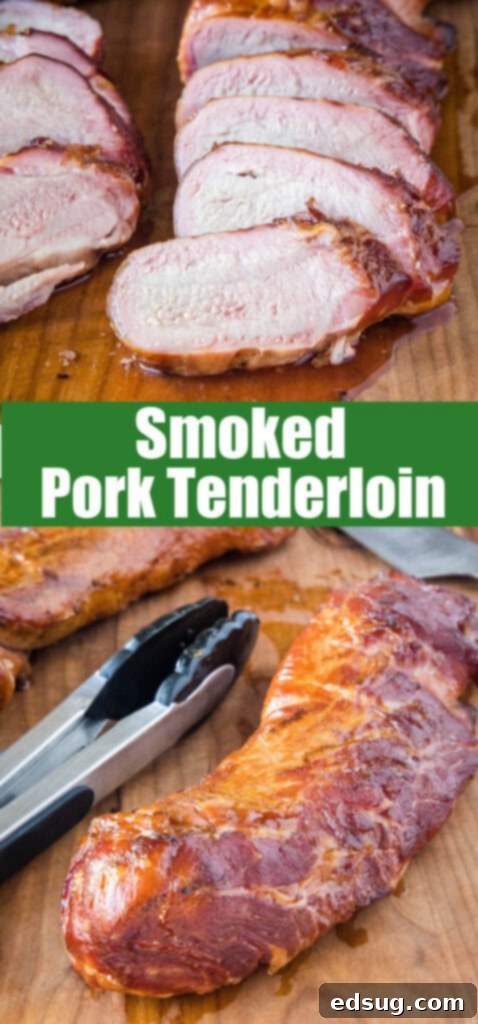
More Tasty Pork Dinner Recipes to Explore
If you love pork as much as I do, be sure to check out these other fantastic recipes that showcase the versatility of this delicious meat:
- Oven Baked Pork Chops
- Pork Lo Mein
- Smoked Pork Belly
- Slow Cooker Pork Roast
- Gyoza (Japanese Dumplings)
- Instant Pot Pulled Pork
- Smothered Pork Chops

Smoked Pork Tenderloin
Pin Recipe
Rate Recipe
Print Recipe
Ingredients
- 2 1- pound pork tenderloins
- 2 Tablespoons honey
- 1 Tablespoon olive oil
- 1 Tablespoon brown sugar
- 1/2 cup low sodium soy sauce
- 4 cloves garlic, minced
- 1 teaspoon onion powder
Instructions
-
Mix together the honey, olive oil, brown sugar, soy sauce, garlic and onion powder. Add the pork and marinade to a food storage bag, seal and squish it around to fully coat the pork.
-
Store in the fridge for at least an hour, up to 24 hours.
-
Preheat smoker to 225º F.
-
Place the pork tenderloins directly on the smoker grate and cook for 60-90 minutes, until the internal temperature reaches 145º F.
-
Let the pork rest for 3 minutes, and then slice to serve. It is great topped with your favorite barbecue sauce.
Nutrition
Nutrition information is automatically calculated, so should only be used as an approximation.
Additional Info
Like this recipe? Leave a comment below!
I created a fun group on Facebook, and I would love for you to join us! It’s a place where you can share YOUR favorite recipes, ask questions, and see what’s new at Dinners, Dishes and Desserts (so that you never miss a new recipe)!
Be sure to follow me on Instagram and tag #dinnersdishes so I can see all the wonderful DINNERS, DISHES, AND DESSERTS recipes YOU make!
Be sure to follow me on my social media, so you never miss a post!
Facebook | Twitter | Pinterest | Instagram
